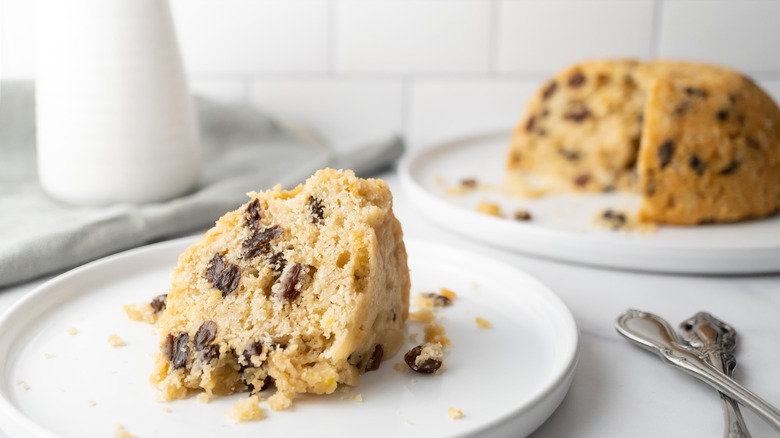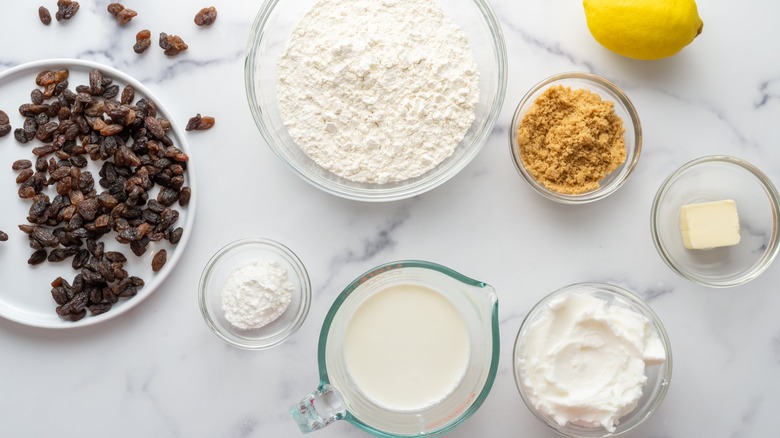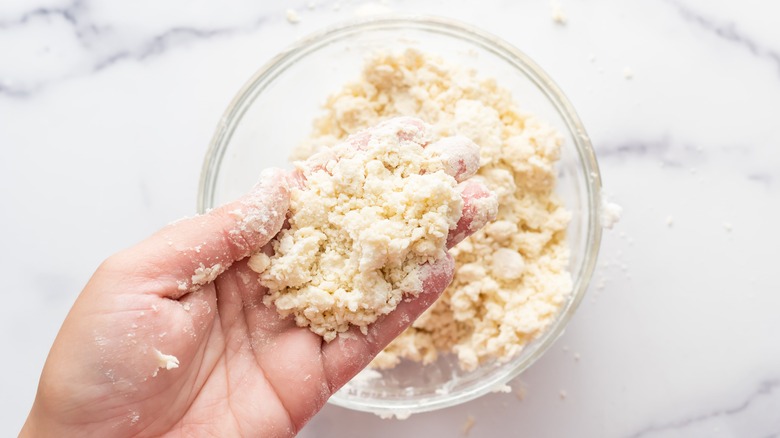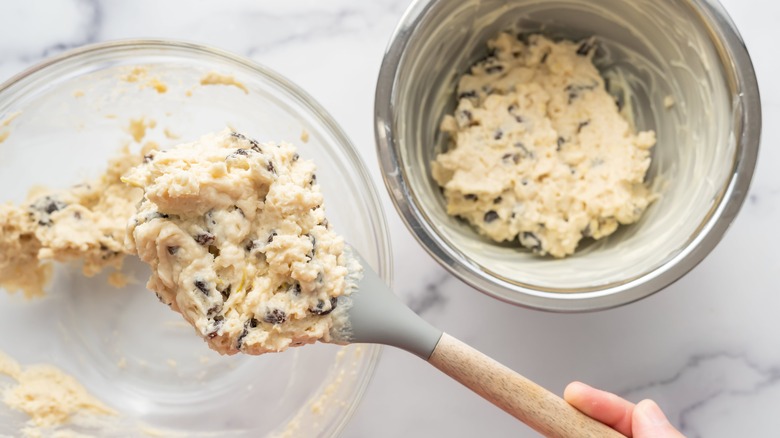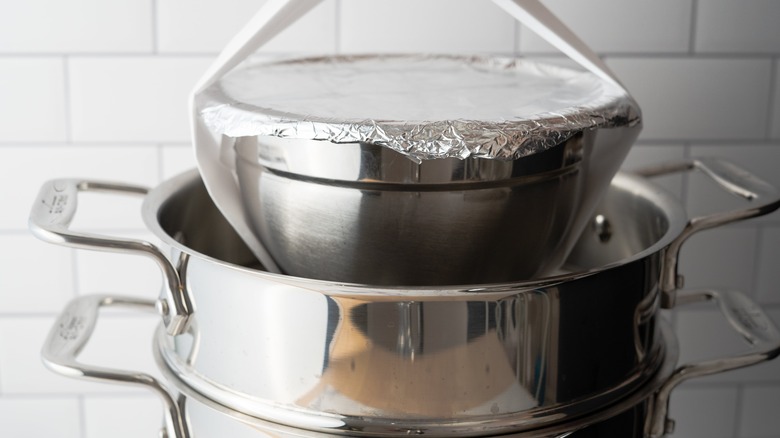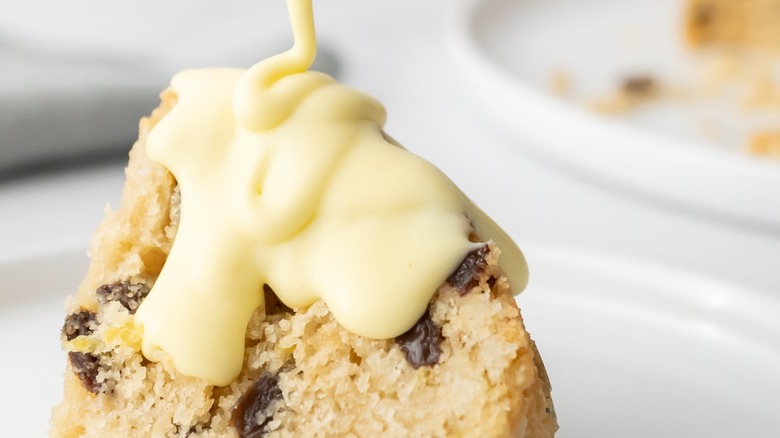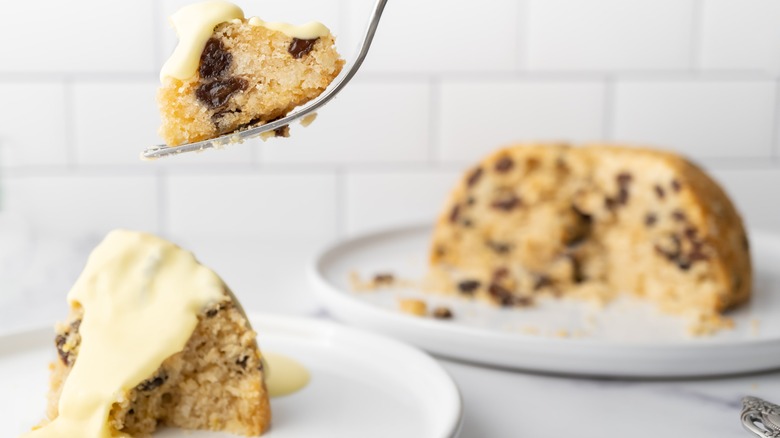Traditional Spotted Dick Pudding Recipe
Despite its rather unfortunate name, spotted dick is a tasty and subtly sweet steamed British dessert bread that your whole family can enjoy. The name comes from the ingredients — traditionally, dried currants, which create the characteristic spots — and an older English name for pudding: puddick. Of course, in the U.S., "pudding" typically refers to a thick custard-like sweet dessert, but in the U.K., puddings are boiled or steamed desserts made with flour. The latter is what to expect when preparing spotted dick.
Traditionally, a spotted dick is made with suet, or hardened animal fat, which can be somewhat hard to come by in the United States. Fortunately, recipe developer Liz Capozzoli of OwlBBaking has come up with a mostly traditional recipe for a spotted dick pudding using more commonly available ingredients. "The texture of the pudding is surprisingly light and delicate, despite there being no eggs in the recipe," Capozzoli says, adding, "I've never made a steamed dessert before and I loved how moist the final result was. This is not an overly sweet dish but still has excellent flavor, with undertones of caramel from the brown sugar, and the raisins were plump and soft." Especially when paired with her optional rich, creamy custard sauce, Capozzoli's recipe for spotted dick is simple to prepare and will provide a delicious finish for any meal.
Get your spotted dick ingredients together
With just a couple tweaks, the ingredients list for this classic British recipe goes from tricky to simple. To make Capozzoli's recipe for spotted dick, you'll need butter, flour, baking powder, vegetable shortening, light brown sugar, currants or raisins, lemon zest, and whole milk. Of course, if you can find it and would rather use the traditional suet in place of the shortening, you're welcome to do that. The method would remain the same.
Additionally, if you're preparing the optional custard sauce, you'll also need heavy cream, separated egg yolks (save the whites to use later in another dish), granulated sugar, and a pinch of salt.
If you're not into raisins or currants, you can always swap them out for other dried fruits or even nuts or chocolate chips, but of course, that would deviate from a traditional spotted dick. "I wouldn't recommend adding anything that changes the moisture levels such as fresh fruit," Capozzoli offers as a word of caution, but then adds, "Although, if you're looking to experiment, try soaking the raisins in a bit of rum before adding them into the mixture."
Combine the flour and shortening
To make the batter, you want to start by combining the flour, baking powder, and shortening (or suet) in a large bowl. Use your fingers to crumble the shortening into the flour, working to incorporate the two until the mixture is uniformly crumbly and is free of large clumps. While this is indeed a messy process, it's important to use your fingers rather than a spoon to combine the shortening and flour together, since it'll be very difficult to achieve the desired texture without getting your hands a little grubby.
Finish preparing the spotted dick batter
Once the shortening is well incorporated into the flour, it's time to add the rest of your ingredients. Stir in the brown star, fruit, and lemon zest until it's evenly distributed throughout the mixture. Then pour in the milk and stir gently (feel free to use a spoon for this step!) until the ingredients have just come together. Don't worry about getting it smooth; this batter is supposed to be lumpy.
Steam your greased bowl
While you're preparing your batter, you can also be getting your water ready to steam. Add a few inches of water to a large pot of water, and place a steam basket or other separator over the top. Select a pudding mold or heat-safe bowl that fits inside your basket or pot, and grease the inside of the bowl well with butter.
Transfer the batter to the greased bowl, then place a piece of parchment paper over the top of the bowl. "The parchment just needs to be draped over the top in the case that the pudding rises so much that it is best to have a non-stick layer there vs. just foil," Capozzoli explains. Cover the whole thing with aluminum foil tightly fitted to the rim of the bowl. You want to make sure that the foil makes a good seal so that no water seeps through.
Use a long piece of parchment, folded lengthwise into a long, thick strip, to lower the bowl into the steamer basket, making sure it's not actually touching the water. Cover the pot and bring the water to a simmer over medium heat. Once the water is simmering, you can lower the heat to keep it at a steady simmer, not a boil.
Optional: prepare the custard
While your pudding is steaming (it should take about 1 hour and 40 minutes on the stovetop), you can prepare the custard sauce, if you're using it. Whisk together the egg yolks, sugar, and salt in a large bowl while heating the cream in a small pot over medium heat, stirring occasionally. Once the cream is hot but not boiling, drizzle it slowly into the egg mixture, whisking constantly, until all of the cream is added.
Return the custard mixture to the pot and heat on medium until the sauce is thickened, whisking constantly. Run the mixture through a strainer to remove any lumps that may have appeared while cooking. If you want to be adventurous, you could even flavor the cream. "For another flavor twist," Capozzoli says, "you can also steep Earl Grey tea bags into the hot cream before making the custard sauce."
You can either serve the custard right away, or allow it to cool and thicken. If you prepare the custard ahead of time, it will keep for a day or two in the fridge. "Be mindful that the custard thickens more as it cools," Capozzoli says. "If it's too thick, you can always thin it back down with a splash of cream."
Prepare to serve your pudding
Once your pudding has finished cooking, use the parchment ends to carefully lift the bowl out of the pot and onto the countertop. Making sure to be careful to avoid hot steam, unwrap the foil and parchment on top of the bowl to check the pudding by inserting a knife or toothpick into the center. If it comes out clean, it's done. If not, replace the foil and place it back into the steamer for a little longer.
After removing your pudding from the steamer, allow it to cool in the bowl for 15 minutes, then invert it onto a large plate. Serve the pudding warm by spooning pieces into individual bowls. If desired, top it off by drizzling it with the custard sauce.
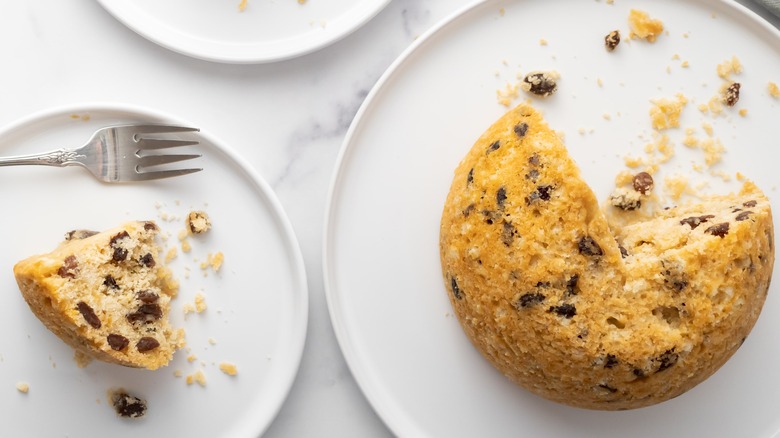
- 1 tablespoon butter for greasing (salted or unsalted is fine)
- 1 ¾ cup all-purpose flour
- 2 ½ teaspoon baking powder
- ½ cup + 2 tablespoons vegetable shortening (or suet)
- 3 tablespoons brown sugar, lightly packed
- 1 cup currants or raisins
- zest of 1 lemon
- 2/3 cup whole milk
- 1 ½ cup heavy cream
- 6 egg yolks
- 2 tablespoons granulated sugar
- pinch of salt
- Prepare a large pot by placing a steam basket or other separator at the bottom. Add a few inches of water to the bottom of the pot.
- Choose a bowl or pudding mold (something heat-safe) that can fit nicely into a pot. Be sure that the water is not touching it at all. Grease the inside of a pudding mold or bowl and set aside.
- In a large bowl, add the flour, baking powder, and shortening. Using your fingers, rub the shortening into the flour until the mixture resembles small to medium crumbles.
- Next, stir in the brown sugar, fruit, and lemon zest.
- Pour in the milk and stir gently until just incorporated. Do not overmix. The batter will be thick and lumpy.
- Dump the batter into the greased bowl. Seal off with a piece of parchment paper, then aluminum foil, ensuring to tuck the foil around the brim of the bowl or mold tightly. It should be very well sealed so no water can get inside.
- Fold another piece of parchment lengthwise to form a long strip of paper. Place the strip of paper under the bowl and using the ends of the parchment, lift the bowl and lower the bowl into the pot. This will help ensure you can easily remove the bowl safely once the pudding is finished cooking, as the pot will be very hot.
- Cover the pot and turn the stove to medium heat to simmer the water. Once simmered, lower if needed to maintain a simmer. Cook for about 1 hour & 40 minutes.
- When ready, using the parchment ends, lift the bowl out of the pot. Carefully unwrap the foil and parchment top and check that the pudding is done baking by using a toothpick or knife inserted into the center. If it comes out clean, it is done.
- Allow to cool for 15 minutes, then invert onto a large plate. Serve warm.
- For optional custard sauce, place the egg yolks, sugar and salt in a large bowl and whisk lightly. Set aside. Heat the cream in a small pot on medium heat, stirring occasionally until fully hot (not boiling). While whisking, slowly drizzle the hot cream into the bowl with the eggs. Continue until all the cream is added. Pour the mixture back into the pot and cook on medium heat until thickened, whisking constantly. Strain the mixture to capture any small clumps that may have formed. Drizzle custard over the pudding. For thicker custard, allow to cool.
| Calories per Serving | 453 |
| Total Fat | 24.6 g |
| Saturated Fat | 7.1 g |
| Trans Fat | 2.9 g |
| Cholesterol | 7.8 mg |
| Total Carbohydrates | 55.0 g |
| Dietary Fiber | 2.9 g |
| Total Sugars | 24.5 g |
| Sodium | 168.8 mg |
| Protein | 5.7 g |
